The forensic testing process can bring a law enforcement officer many challenges. All too often, officers must collect or test for the presence of fingerprints, blood, drugs, or explosive materials after responding to a call. Collecting and testing these samples can often take hours; not to mention that often samples must be shipped to a laboratory for analysis, taking days, if not weeks or months, to provide results.
In many cases, the traditional presumptive field tests rely on highly concentrated acids and carcinogenic liquids. Additionally, the delivery of presumptive tests requires officers to break glass vials and ampoules containing these dangerous liquids. The broken glass can lead to officer injuries or result in the test pouch being punctured, which could expose the officer to chemical components of the test as well as the potentially dangerous drugs within the sample.1
Many companies have heard these concerns and have placed their focus on making low-cost forensic testing that is safe, simpler, and more effective.
Test Kits
Presumptive field testing involves technology that has been unchanged for decades. Without an alternative, officers were forced to choose between using dangerous tools or not testing at all.
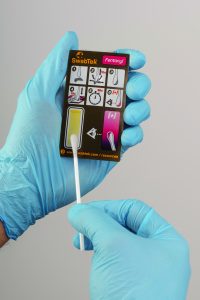
The California-based SwabTek, however, hopes to revolutionize the presumptive field testing space. “For some departments, the inherent risks of using the acids and glass components of those tests in the field had reduced the frequency with which they were used, with some departments even going so far as to eliminate field testing from their procedures at all,” said Mitchell Ballachay, Strategic Projects at SwabTek.2 Prioritizing officer safety, the company’s proprietary and novel test kits replace the hazardous liquid chemicals and complicated procedures of traditional test kits with the simple and safe dry reagent technology.
SwabTek manufactures single-use, presumptive field tests for narcotics, explosives, and gunshot residue. The narcotics test kits are each designed to screen for a specific class of narcotics, or a general narcotics test kit is available to screen for multiple drug classes. The explosives kits can screen for dry and liquid explosives and precursors.
The glass delivery of the traditional tests has been replaced with a swab. An officer can simply dab the suspect material and transfer the sample to the test paper. The reagents used in SwabTek’s tests are printed in a dry format onto paper and do not include hazardous chemicals that would put officers at risk of exposure. When a sample is combined with the reagent printed on the test paper, a positive result is indicated by an immediate color change. Unlike many traditional tests that require acid neutralizers and special disposal procedures, SwabTek’s tests are perfectly safe to dispose of once the tests are completed.
“Despite their simplicity, they have been independently validated to perform to the same analytical standard as other tests on the market but with a procedure that is simple and does not put officers at risk,” said Ballachay.
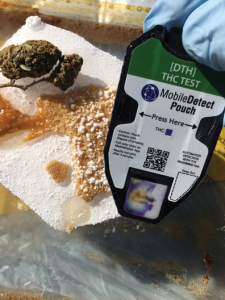
Also utilizing a swab method within their tests is DetectaChem. Based out of Sugar Land, Texas, the company’s primary offering to the law enforcement community is their MobileDetect field drug test kits. DetectaChem’s test kits have been in use since the 1970s, but the drug world has evolved immensely since then; this brought about the MobileDetect test kits. “Almost every narcotics officer we talk to has either cut their fingers using a NIK test or knows a colleague who has. When you’re dealing with potent drugs like fentanyl, a dangerous exposure like that can potentially cause an overdose,” said Marketing Manager Bryan Beaty. “That’s why every aspect of our MobileDetect test kits was engineered with officer safety at the forefront.”3
Every test kit comes with a removable swab that an officer uses to sample a suspect substance. The swabs are capable of trace and bulk sampling, meaning that officers would not need to scoop copious amounts of drug material into a kit. Once the substance has been sampled, the officer inserts the swab into the MobileDetect pouch, crushing the ampoules inside, releasing the testing reagent, and forming a visible color reaction. The test results can be analyzed visually by the officer, and they can be automatically captured by scanning the test kit with a mobile application.
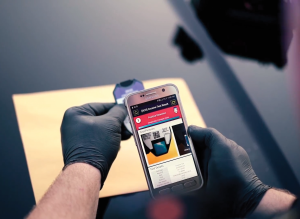
Each of the MobileDetect kits is equipped to screen for specific drugs; some can even detect several types of drugs at once.
Available on Apple and Android devices, the MobileDetect app captures the moment in time that a test has been completed and automatically creates a report for the officer the includes pertinent details such as time and date, location, test result, and images.
With a focus on roadside drug testing, Abbott is providing a quicker, less-invasive way to confirm whether a driver is under the influence of drugs. Oral fluid testing has emerged as the company’s promising alternative to blood and urine tests.
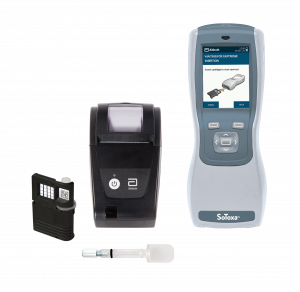
Abbott’s portable roadside device, the SoToxa Oral Fluid Mobile Testing System, is a handheld drug testing unit designed to detect the recent intake of six classes of common drugs of abuse within five minutes. Because SoToxa uses oral fluid to screen for the active presence of the parent drug—not the drug’s metabolite—it registers only recent usage and will not indicate historical drug usage. Once the cartridge is inserted, the SoToxa conducts a validation process, which takes only seconds, to ensure it has not already been used and has not expired. It then prompts for the collection swab to be inserted into the cartridge, showing the on-screen results within five minutes.
The SoToxa test kit also comes with a set of positive and negative QC cartridges that should be used to validate that the system is working properly.
Roadside testing has already been successfully implemented across the world, saving lives not only of passengers in a vehicle with a drug-impaired driver but also the driver themselves. In a pilot program with the Michigan State Police, a positive result using SoToxa led to the driver asking for help in accessing a recovery and rehabilitation program.4
Biometric Identification
In many cases, small and mid-size agencies may lack the means to access the same forensic technology as large agencies. However, IDEMIA is providing a cost-effective solution for state and local agencies through STORM, the first cloud-native automated biometric identification system (ABIS).
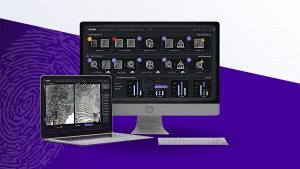
The out-of-box SaaS streamlines the system deployment and leverages IDEMIA’s MBSS matching algorithms for latent and tenprint examination. Available through AWS, its intuitive user interface improves examiner efficiency and reduces training time by putting all necessary comparison and analysis tools in one integrated environment. Because STORM is accessible from anywhere via a secure internet connection, officers can process fingerprints at home, in the office, or directly from the crime scene. There is also no need for in-house IT support as the system is backed by around-the-clock support from IDEMIA experts.
“STORM ABIS is innovative and scalable, providing continuous updates of algorithms, feature and security patches, and [it] supports room to grow as an agency’s needs grow,” explained IDEMIA’s communications director, Christopher Doherty.5
Forensic Resources
Advancing forensic science helps to prevent crime, support the larger criminal justice system, and promote public safety. However, information on technology specifications and applications, state of the science, decision-making criteria, policy and practice, and user experiences have not always been easily accessible to law enforcement professionals. That is where the Forensic Technology Center of Excellence (FTCoE) can help.
Led by RTI International, the FTCoE is supported through a cooperative agreement from the U.S. Department of Justice’s National Institute of Justice, Office of Justice Programs. According to Dr. Jeri Ropero-Miller, “The FTCoE bridges the gap between the scientific and justice communities by engaging and collaborating with professionals within government and law enforcement agencies, academia, forensic laboratories, and legal and medicolegal offices to foster safer communities through research, outreach, education, and advocacy.”6
The center maintains a website that serves as a centralized resource where law enforcement personnel can access a broad range of resources by attending webinars, listening to podcasts, or browsing through the publication library. The slate of offerings is guided by four focus areas, including (1) managing the testing and evaluation of emerging technologies; (2) assisting with knowledge transfer and integration; (3) leading the transition of research into the hands of practitioners; and (4) creating communities of practice to address current and future issues, threats, and challenges. Through numerous collaborative efforts, the FTCoE engages members of the criminal justice community with important new information, best practices, timely discussions, and evaluations of emerging technologies at no cost.
“By moving research into practice, the FTCoE focuses on the implementation of promising technologies and practices used by the justice systems—from the scene investigation to the forensic laboratories to the courtroom,” said Dr. Ropero-Miller.
Whether testing for drug intoxication or examining fingerprints, technologies are constantly evolving, often making processes simpler and safer for the user. Police leadership should become knowledgeable of the research and technology available in order to save costs as well as lives.d
Notes:
1Mitchell Ballachay (strategic projects, SwabTek), email interview, July 19, 2022.
2Mitchell Ballachay (strategic projects, SwabTek), email interview, July 19, 2022.
3Bryan Beaty (marketing manager, DetectaChem), email interview, July 29, 2022.
4Fred Delfino (law enforcement liaison, Abbott Laboratories), email interview, August 2, 2022.
5Christopher Doherty (director of communications, IDEMIA), email interview, August 1, 2022.
6Jeri Ropero-Miller, PhD (principal scientist, RTI International), email interview, August 1, 2022.
|
SOURCE LIST Please click on the companies’ names to go to their websites or visit the Police Chief Buyers’ Guide to request information from companies. |
||
|
Forensic Technology Center of Evidence |
|
|


